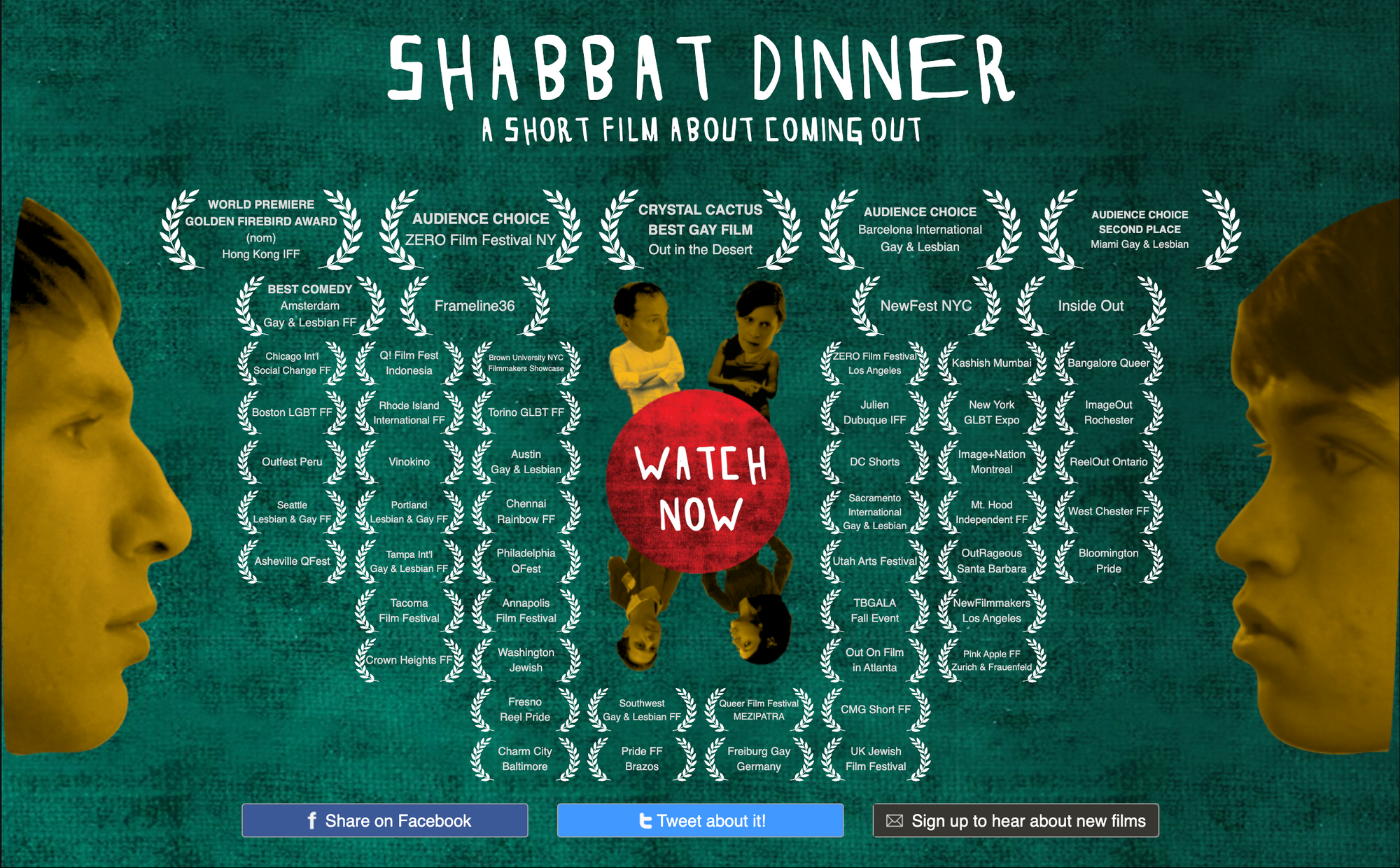Good self-distribution: Nobody controls the gates but you

Alexis Whitham, Director of Educational Programming & Acquisitions at the Frameline Film Festival, asked for 50-100 words about my process in creating a distribution portal for Shabbat Dinner, where you can pay what you want, and once I started I couldn’t stop until I had about 1,000. I thought it would be great to put some of the knowledge I’ve learned out there for use by everyone.
Getting started
Like many who got into the self-distribution game, I was at first hoping to score a more traditional distribution model. It had been so much work to finish the film, and it was very compelling to think that I could sell it, make some money, and have experts working to get it out to as many people as possible. I contacted Shorts International and Indieflix and got a no from both of them. (Funnily enough, a week after Indieflix said no I got an email from someone else at the company asking to look at the film, who then rejected it again.)
I think the key to good self-distribution is a realistic assessment of your audience (current and potential), the viewing experience you want to create, and what human and technological resources you have available. By all means look at what others are doing, but also think about what you can do that is unique. What about the screening experience will be best for your film? Is there additional content or another perspective or community that would add something to the film? What can be improved on real-world screenings in an online setting? What might people want to see after watching your film?
Shabbat Dinner had been well received on its festival run, so I knew it had fans who would want to watch it again or recommend it to others. I also had a great network of over fifty film festivals, and I was hoping that some of them would use their considerable social media might to help promote the film.
The site
I still remember the night I created the site. I was inspired by Amanda Palmer’s TED talk on developing a relationship with fans, and her message that fans want ways to support the artists they love. I wanted to make the film available under a pay-what-you-want model, but Tinypass, my payment processor, would not let me charge less than $1, so that was set as the minimum.
It’s important to establish the value of the product as a first step in the relationship. When visitors arrive at the film’s site, shabbatdinnerfilm.com, they are greeted with quoted reviews of the film and a screen overflowing with festival laurels. The page is designed to say “this is a film worth watching.” If they’re not convinced, there’s also a link to the trailer. The text emphasizes how simple the purchase will be (“in seconds”) and mentions that the typical price for a film festival ticket is $9.
Setting the reference point of $9 was very helpful. The first few purchases of the film were for $10, and after a few months I had settled into an average purchase price of $4/view, which is completely unprecedented in this industry.
I added a live q&a using Olark, software that connects a chat box in the corner of the page to my gchat, and therefore my cell phone. Wherever I am, somebody watching the film can message me to ask questions about the film or just say hi.
I also added a Facebook-enabled comment box below the film, with a prompt asking viewers to tell me what they think. By default, commenting creates a post on that viewer’s Facebook wall with their comment and the page’s Facebook share text: “Watch Shabbat Dinner short film – Pay what you want!” with a description beginning “Watch the film the Huffington Post calls “A funny, revelatory family dinner” and pay what it’s worth to you.” This makes it very easy for viewers to recommend the film to friends, and once they do, the film speaks for itself on their timeline.
Going viral
It’s very important to be ready for attention from the internet. All of the elements on the page that encouraged easy sharing and immediately introduced the film to a newcomer have set up Shabbat Dinner to go viral. If a well-placed tweet or mention sends a few hundred people to the site, the film could spread very quickly. Plus, my use of Amazon’s S3 service for the hosting means that my site can handle any amount of traffic the web wants to throw at it.
More platforms
Non-exclusive and multiplatform are the name of the game. Major hollywood films can release on a dozen platforms, and it just makes sense to be on as many as you can, PROVIDED they give you fair revenue sharing and contract terms, and remain non-exclusive so you can keep your rights. After all, there’s no problem in competing with yourself.
Shabbat Dinner has since become available on Seed&Spark, Amazon DVD and VOD, TLA releasing, and a DVD compilation called “Green Briefs.” I’d love to put it on iTunes and Netflix, but I haven’t found a distributor who wants to help.
The next step for the film is an attempt to reach a teenage audience. It was meant for younger people, yet so few have actually seen the film. I’d like to get in touch with GSA’s and other youth organizations over the next year and spread the film that way.
I want the ultimate home of the film to be be on YouTube, available for free. It’s a short and I didn’t create it to make money. Making it available for free increases its exposure and relevance in our culture by orders of magnitude, and could help my career more than keeping it hidden away. For those considering just releasing their short for free on YouTube, I don’t think it’s a bad decision at all.
For now, though, I’ve decided that a free release online would limit the film’s prospects more than help them. It wouldn’t have a chance of getting onto iTunes or into future festivals. Plus, the non-exclusive agreements I’ve signed are contingent on the film not being available online for free.
For those interested in the technical aspects of the site, I’ve encoded the video at multiple bitrates and am serving it through Amazon S3 with a custom javascript player that detects the user’s bandwidth. I’m using the PHP Tinypass toolkit to set a login variable which determines whether to show the welcome page or the actual film. Tinypass also now offers a custom module for charging for videos, which could well be a perfect solution for self-distribution.
The next film
So after everything I’ve learned this go-around, how am I doing things differently next time? For my upcoming short Lily in the Grinder, an expressionistic film on temporality and death, I would like to begin with a traditional festival distribution route, with a twist. The film is very dense and designed to be watched multiple times and paused and rewound at will.
I would like to provide a code at the end of the credits that will allow those in the theater to go online and watch the film again as many times as they want, which retains festival exclusivity while allowing for rewatching. There’s ways for everyone to win!
Open for questions!
I’m happy to consult with those who are looking to put their film out there on both technical and promotional issues. You can always reach me at michael@everythingiseverything.com.
